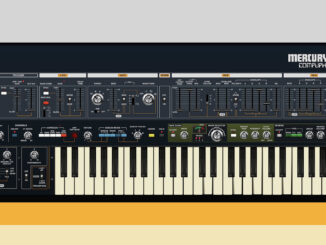Cherry Audio Minimode has captured the legendary spirit of the Minimoog and put in a new emulation with 16-voice polyphony and MPE support.
The Moog Minimoog, a legendary analog Synthesizer. The basis was the sound of the equally legendary monster Moog Modular but in a more compact, affordable version. Developed by Dr. Robert Moog in the late 1960s and officially released in 1970. It was a milestone for the Synthesizer instrument because it was the first to be sold in music shops.
To this day, the instrument inspires musicians with its fat analog sound and simple interface. The inspiration goes all the way to the developers. It is one of the most emulated synths in the plugin scene. And today there is another Minimoog emulation. With the Minimode, Cherry Audio now also has one in its still young portfolio.
Cherry Audio Minimode
Minimode is a faithful virtual analog emulation or recreation of the legendary Moog Minimoog Model D. Cherry Audio does not experiment with the engine and gives the user all the features of the original hardware unit.
Three multi-wave oscillators, classic four-pole 24dB/octave ladder filter with emphasis and contour control, feedback and sidechain, two envelopes… There are no extra features like LFOs, extra modulation, or effects like in the other CA emulations. The developers want to keep it as authentic as possible or in the CA’s words: “absolute authenticity”.
The emulation is created with frequent collaborator Mark Barton (MRB) and both sides have analyzed and studied the Minimoog down to the last detail. It went so far that they virtualized the original interface at the same time. Including the maple cabinet, textured surface, and the iconic “Cosmo” knobs and switches.
Polyphony
However, some modern features have moved into Cherry Audio’s take on the Minimoog Synthesizer.
The biggest difference from the original is the number of voices. Minimode can be played either in originally monophonic, duophonic (two voices), or in polyphony with up to 16 voices. A switch on the interface lets you easily set the mode. Thus, you get a polyphonic Minimoog with the same fat, rich sound as the original monophonic version. And according to the Cherrys, the plugin uses highly optimized coding for optimal performance with ultra-low CPU load.
Then they equipped the engine with MIDI polyphonic expression (MPE) support making expressive performances possible using MPE-compatible controllers. Minimode also has complete MIDI control and DAW automation for all controls with MIDI learn. Also new is the ability to save custom MIDI controller mappings to individual presets, globally or both at the same. A very handy functionality and a great addition.
Presets
The Minimoog is one of the easiest to use synthesizers ever built. Anyone who has some experience with synths can use it without any problems. Its foolproof user interface invites you to tweak the sounds. It’s definitely one of the characteristics that made the synth so legendary.
For those who prefer professional crafted sounds, the Minimode also incorporates a preset browser that includes over 250 presets including brass, keys, percussions, leads, sound effects, pads, and more.
First Impression
The Minimoog is among the most emulated synthesizers in the plugin world. Keeping track of who has one and who doesn’t is difficult. But Cherry Audio has developed a solid Minimoog emulation here. Sonically on a very high level and can keep up very well with the competition. An in-depth sound demo is coming later today!
I find it good that the CA developers have focused on the essential and important parts and not added any bigger extra functions.
Cherry Audio Minimode is available now for an introductory price of $39 USD (reg. $69 USD). It runs as a VST, VST3, AU, and AAX plugin and standalone on macOS (Intel + M1) and Windows.
More information here: Cherry Audio
Available at our partner





“Also new is the ability to save custom MIDI controller mappings to individual presets, globally or both at the same. A very handy functionality and a great addition.”
This has been on the top of some wishlists, in the windcontroller community, for Cherry Audio softsynths. We often map breath to filter cutoff.
Relatedly, a windcontroller player has shared that the ladder filter only goes down to 32Hz so playing notes in the low range creates an unwanted popping effect.
Still sounds pretty good overall.
https://www.youtube.com/watch?v=Lz1LUDPnjaI